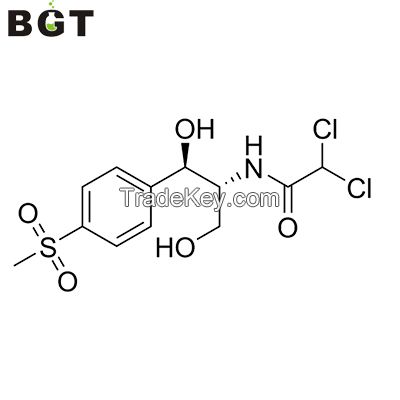タイトルまたは説明
Name: Thiamphenicol
Synonyms: thiophenicol, dextrosulphenidol, Win *****2, CV***3
Chemical names:
D-d-threo**-dichloroacetamido**-(*-methylsulfonylphenyl)*1,*-propanediol;
D(+)-threo**-(4'-methylsulphonylphenyl)**-dichloroacetamide
propane*1, *-diol;
D-threo*2,*-dichloro-N-ï¢
-hydroxy-a-(hydroxymethyl)-p-(methylsulphonyl)-phenethyl acetamide
(C.A.S. name)
CAS No.: *********3
Molecular formula: C*2H*5Cl2NO5S
Molecular weight: **6.*2
Melting point: ******6°C
Appearance: White crystalline powder
Solubility: Highly soluble in lipids; soluble in dimethylacetamide,
dimethylformamide (DMF) and acetonitrile; slightly soluble in
absolute ethanol and acetone; practically insoluble in water,
ether, ethyl acetate and chloroform.
Stability:
Can be kept for 5 - 6 years when stored in closed containers and
protected from humidity and excessive heat.
What is thiamphenicol?
Thiamphenicol is an antibiotic active against both Gram-positive
and Gram-negative bacteria and particularly effective against
anaerobes. It is used for parenteral therapyas the water soluble
thiamphenicol glycine hydrochloride and for oral use, as a premix
of thiamphenicol base and corn starch. In many countries,
thiamphenicol is used as a veterinary antibiotic, especially for
the treatment of infectious diseases in cattle, pigs and poultry.
In China, Morocco, Italy, and Brazil, it is also for medical uses .
In particular, it is used for treating sexually transmitted
infections and pelvic inflammatory disease. may be used in the
treatment and control of a wide range of respiratory and alimentary
tract infections of bacterial origin in calves, pigs and poultry.
The oral product is not suitable for the treatment of cattle with
functional rumen.
Advantages of thiamphenicol over chloramphenicol
As the methyl-sulfonyl analogue of chloramphenicol, thiamphenicol
has a similar antibacterial spectrum, and it inhibits protein
synthesis in bacteria as chloramphenicol does. However, it excels
in several ways.
The main advantage of thiamphenicol over chloramphenicol is that it
can be extensively used in human without being associated with
aplastic anaemia.
Whats more, while chloramphenicol is readily metabolized in cattle,
poultry, sheep, and humans, most thiamphenicol is excreted in its
original form. Specifically, it is excreted both as parent drug and
as thiamphenicol glucuronate in pigs and rats.
Moreover, the concentration of thiamphenicol in blood and other
body fluids such as bile is higher than chloramphenicol.
Relevantly, it is 2.5 to 5 times as effective as
chloramphenicol.
The antimicrobial activity of thiamphenicol
Thiamphenicol is effective in inhibiting a broad range of
microorganisms, and its antibiotic actions work for some species
under certain conditions. Relatively low concentrations of
thiamphenicol is active against Clostridium, Corynebacterium
diphtheriae, Diplococcus pneumoniae, Staphylococcus albus,
Streptococcus pyogenes, Streptococcus viridans, Bacteroides,
Fusobacterium, Bordatella, Brucella, Haemophilus, Neisseria,
Pasteurella, Shigella and some vibrio strains. The bacteria
sensitive to moderate concentrations of thiamphenicol include some
Bacilli, Erysipelothrix, Staphylococcus aureus and Streptococcus
faecalis. To inhibit Listeria, Aerobacter, Escherichia, Klebsiella,
Proteus and Salmonellae, relatively high concentrations of
thiamphenicol is required.
The thiamphenicol compound is effective against Mycoplasmas,
Treponema, Rickettsias, Entamoeba and Actinomycetes. There is no
difference between the in vitro antimicrobial activities of the
thiamphenicol glycinate ester and that of thiamphenicol base.
Dosage
The usual daily dosage of thiamphenicol for calves (not for oral
use because of their ruminating attribute) is *0 - *0 mg/kg (*0
mg/kg in dairy cows, and for sucking calves *0 mg/kg of body
weight), for pigs *0 - *0 mg/kg , and for poultry *5 to *7
mg/kg.
Development of thiamphenicol
Thiamphenicol was artificially synthesized by Cutler et al in ***2
in the U.S.. It was then manufactured in the U.S., Italy and Japan
successively. From ***0, it was written into British Pharmacopoeia
and broadly applied in Europe as a new chemical therapeutic agent.
In China, thiamphenicol was used in clinical veterinary in
***0s.
Since the end of ***0s, thiamphenicol was exported to Japan and
sold to Taiwan from Mainland China in bulk. Its prices therefore
rose continuously and the supply is constantly
sufficient.
| 国: |
China |
| モデル番号: |
-
|
| 离岸价格: |
(交渉可能)
Get Latest Price
|
| ロケーション: |
- |
| 最低注文量の価格: |
- |
| 最低注文量: |
- |
| パッケージの詳細: |
- |
| 納期: |
- |
| 供給能力: |
- |
| 支払いタイプ: |
- |
| 製品グループ : |
- |

